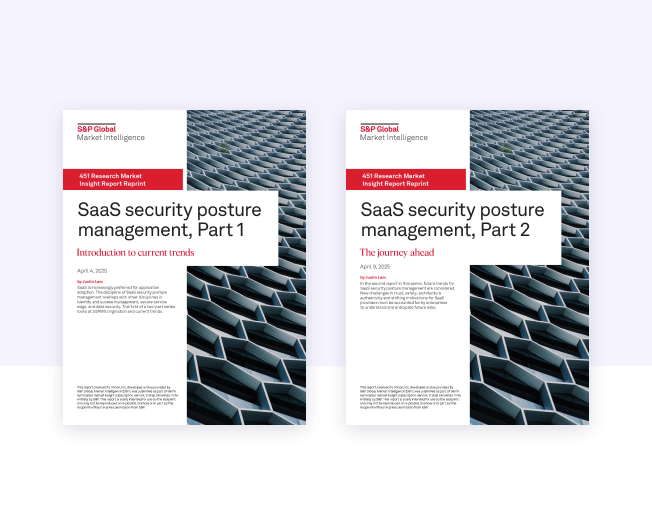RESOURCES > VIDEO
No Boundaries - Why AI and SaaS Are Now the Same Attack Surface
Why AI and SaaS Are Now the Same Attack Surface and How to Close Your Security Gaps
The lines between SaaS and AI security are vanishing. AI agents are now first-class citizens in your SaaS universe—accessing sensitive data, triggering workflows, and introducing new risks that legacy SaaS security posture management tools (SSPM) miss. Security teams are discovering that managing SaaS in isolation from AI is a recipe for dangerous blind spots.
Watch Justin Lam, Security Analyst at 451 Research, and Amir Khayat, Co-Founder & CEO of Vorlon, in a lively discussion where they cover:
- How SaaS and AI have converged into a single, dynamic attack surface
- Key findings from 451 Research’s latest SaaS security research
- The ShinyHunters Salesforce attack and the new reality of “shared fate” in SaaS and AI security
- The Gap between perception and reality in SaaS risk
- What unified SaaS + AI security actually looks like in practice
Relevant 451 Reserach on Unified SaaS and AI Security:


About the speakers

Amir Khayat
CEO and co-founder of Vorlon
Amir Khayat is the CEO and co-founder of Vorlon, a cybersecurity company that helps enterprises secure the sensitive data flowing across their converged SaaS and AI ecosystem. Amir’s journey through twenty years in cybersecurity has taken him from hands-on software development to being a founding team member at Demisto, the widely adopted SOAR platform, and through Demisto’s acquisition by Palo Alto Networks, where he ran global solutions engineering for their XSOAR platform. But while helping hundreds of global enterprises automate and streamline their security operations, Amir saw a new and rapidly growing need to protect sensitive data in motion from one system to another. He graduated from Reichman University, Herzliya, Israel (IDC) with a BA in Computer Science, and he holds an MBA from the Hebrew University of Jerusalem.
.png?width=1200&height=1200&name=justin%20lam%20circle%20(1).png)
Justin Lam
Senior Research Analyst at 451 Research
Justin Lam is a Senior Research Analyst at 451 Research. Justin leads data security research, and if you’ve read any of his work, you know he has a rare ability to bridge the gap between what security buyers need and why vendors innovate. Across his career, Justin has worn just about every hat—from engineering and product management to customer success and sales leadership—and he’s been part of five successful exits, including two IPOs.
Executive summary: Securing the Converged SaaS and AI Ecosystem: What CISOs and Practitioners Need to Know
Traditional security frameworks don’t fit today’s reality
The enterprise perimeter has shifted. Organizations are no longer securing just endpoints and networks. Sensitive data now moves across a converged SaaS and AI ecosystem where:
- SaaS applications are interconnected through APIs and OAuth integrations
- AI copilots, agents, and automations access sensitive records with organizational authority
- Data constantly flows between human and non-human identities
Legacy SSPM and DSPM tools were designed for static environments. Today’s attack surface is dynamic, interconnected, and much harder to govern.
Nearly every organization runs on a converged SaaS and AI ecosystem
Justin Lam, 451 Research:
“Security has never been a solitary effort. Enterprises now operate inside a converged SaaS and AI ecosystem — one unified attack surface. If you treat SaaS and AI separately, you’re already behind.”
What defines this shift:
- Broad SaaS adoption makes apps the backbone of daily business operations.
- AI models and copilots act at machine speed, moving sensitive data instantly.
- Together, they form a SaaS+AI ecosystem moving faster than most security frameworks can address.
Why Vorlon was founded
Amir Khayat, Vorlon:
“Organizations don’t own their data pipelines anymore. They flow through the converged SaaS and AI ecosystem. Vorlon was built to restore visibility and control for security teams operating in this new environment.”
Key founding insights:
- Enterprises lost direct ownership of data movement.
- Productivity gains created fragmented oversight.
- Security teams need a way to see, govern, and remediate risks across SaaS+AI ecosystems.
The attack surface expands with SaaS and AI convergence
The converged SaaS and AI ecosystem accelerates work, but it also widens exposure:
- SaaS apps, plug-ins, and AI add-ons increase data touchpoints
- Secrets and tokens power integrations without oversight
- Shadow SaaS and AI tools bypass security review
- Sensitive data-in-motion is rarely governed end-to-end
Amir Khayat compared this to driverless cars: you trust them until the moment they don’t behave as expected. Security leaders cannot rely solely on vendor assurances.
Cracks in the shared responsibility model
The ShinyHunters phishing campaign exposed Salesforce customers without breaching Salesforce itself. Attackers used OAuth abuse to compromise customer environments.
Justin Lam:
“The shared responsibility model often feels like shared fate. Vendors can’t be accountable for risks across your converged SaaS and AI ecosystem.”
Enterprises must take ownership of how SaaS and AI integrations are secured, monitored, and remediated in their use.
Shadow SaaS and shadow AI
Every organization already runs on more SaaS+AI tools than leadership realizes.
- Unsanctioned SaaS apps create hidden connections
- AI copilots and plugins access data without approval
- Inter-app automations silently move sensitive information
Mapping the converged SaaS and AI ecosystem is the first line of defense.
SaaS and AI convergence drivers
According to 451 Research, three forces are accelerating the convergence of SaaS and AI:
- Frictionless adoption — with low-code and API-first design, new SaaS+AI tools are added easily, often outside IT.
- Vendor stickiness — established SaaS vendors embed AI into their platforms to deepen reliance and lock-in.
- Reward-first culture — enterprises prioritize productivity and innovation over controls, leaving governance gaps.
Shared risk vectors across SaaS and AI
Amir Khayat notes that the risks are not separate; they converge inside one ecosystem:
- Overshared access rights and privilege drift
- Shadow SaaS and AI usage outside IT governance
- Data exfiltration risks from opaque data flows
- Non-human identity (NHI) risks from service accounts, tokens, bots, and AI agents
These are now shared risks across the SaaS+AI ecosystem, not siloed categories.
Data is the constant
Justin Lam:
“No matter how fast the SaaS and AI landscape evolves, the constant is the data. Protecting data-in-motion across the converged SaaS and AI ecosystem is the only sustainable defense model.”
CISOs should prioritize risk management by data impact: intellectual property, customer records, employee HR data, and regulated financial or healthcare information.
Case study: stopping ShinyHunters in the SaaS+AI ecosystem
Amir shared how Vorlon detected and mitigated a Salesforce-focused OAuth compromise aligned with ShinyHunters tactics:
- Discovery: Vorlon monitored eight SaaS applications but auto-detected 51 downstream connections, including AI tools
- Detection: Alert triggered when a new OAuth app with full permissions appears
- Enrichment: Vorlon correlated identity misuse, TOR IP communication, and data-access patterns
- Response: Tokens revoked automatically or delegated to IT. Mean-time-to-response reduced from weeks to minutes
This shows the importance of continuous monitoring across the entire converged SaaS and AI ecosystem, not just the primary vendor app.
Secure by design vs. secure by operation
- Vendors may design their SaaS+AI products with security features.
- Enterprises still need to operate their own environments securely.
That requires:
- Continuous monitoring of every new connection
- Governing tokens and non-human identities
- Rapid detection of abnormal behaviors and data flows
Closing insights
Key takeaways for security leaders:
- Visibility is foundational. You can’t secure what you can’t map.
- Shared responsibility ≠ shared protection. Enterprises must secure their own use cases.
- Data-in-motion is today’s perimeter inside the converged SaaS and AI ecosystem.
Amir Khayat:
“Don’t cede your company’s security destiny to SaaS vendors. The future is proactive, unified defense across the converged SaaS and AI ecosystem.”
Next steps for security leaders
- Map your converged SaaS and AI ecosystem: uncover every sanctioned and shadow connection
- Treat non-human identities like users: monitor bots, scripts, tokens, and copilots carefully
- Secure data-in-motion: track and prioritize risks by the sensitivity of data flows
- Invest in unified SaaS+AI ecosystem security platforms: avoid piecemeal tools that create blind spots